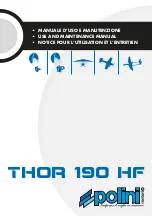
14)
Fuel is combustible and therefore must be kept in an enclosed container at a safe distance
from the engine when it is running.
15)
When preparing fuel carefully follow the manufacturer’s or dealer’s instructions.
16)
Small objects must be kept at a safe distance from the engine when it is running. Never
throw any objects towards the spinning propeller.
17)
Be careful in choosing the location where you wish to start the engine. Avoid dusty or
sandy areas.
18)
Start the engine in well-ventilated areas only. Never start the engine indoors.
19)
When starting the engine make sure that bystanders, especially children, are at a safe
distance of at least 10 m.
20)
The engine power output makes it possible to fly big models. Mal-operation of such
models may cause serious damage. Start using the MVVS 50 in model planes only after
you have mastered operating smaller models.
Selecting a suitable propeller
It is usually the case that propellers of the same dimensions coming from different
manufacturers are not the same. Sometimes even propellers of the same dimensions produced
by a same manufacturer are not the same. The engine power is best utilized when the propeller
dynamics curve and engine power curve (revolutions/power output) intersect in the area of the
engine’s maximum power output. Unfortunately, no propeller manufacturer provides this
information. Engine power output is also a variable quality. It depends above all on the
silencer used and can vary considerably. The situation is further complicated by environmental
parameters (temperature and atmospheric pressure in particular): low temperature and high
pressure increase propellers’ input requirements by 20% in comparison with input at hot
weather.
Suggested propeller dimensions:
two blade:
22x10, 22x12, 22x14
23x8, 23x10, 23x12
24x8, 24x10, 24x12
three blade:
21x10, 21x12, 22x8, 22x10
These values are only approximate and may vary with the factors described in the previous
section, as well as with the type of the exhaust system used.
The MVVS 50 has been designed to generate maximum power at 6100–6300 RpM, according
to the type of exhaust used. If you wish to utilize the maximum power output, choose a
propeller, which allow the engine to reach these revolutions, or slightly lower revolutions
(given that the unloading of the propeller depends on the speed of flight) on the ground.
We do not recommend using propellers with which the engine reaches more than 7500 RpM
on the ground.
When fixing the propeller to the engine tighten the central nut and each screw several times
over. Finally tighten the washer screws once again in sequence across each other.
Fuel
Always use unleaded 95-octane petrol mixed in the proportion 40 volume units of petrol to 1
unit of Mobil Racing 2T oil. If necessary, any quality brand-name synthetic oil intended
for racing two-stroke engines can be also used.
Running the engine in, use the MVVS Racing 2T oil, that comes with the engine. Mix it in the
proportion 30:1.
Never use inexpensive oil developed for garden appliances or synthetic oils intended for the
operation of methanol model engines. The manufacturer declines all responsibility for all
engine damages arising from the use of low-quality fuel.
Store fuel in containers designed for this purpose. Do not use mixed fuel older than 90 days.
Assembly
The engine is fastened in place by means of the four holes in the rear cover. The rear cover is
adjustable by 90
°
which ensure easy access to the carburetor’s operating elements. The engine
can be mounted directly to the firewall or an assembly kit can be used (special accessories).
Use M6 screws or screws M5 with a reduction kit (special accessories). If you decide to fasten
the engine using flexible motor mounts, always choose parts with enough solidity and strength.
Make sure to secure the screws against loosening and regularly check that they are tightened
up and in good condition.
Since air is used to cool the engine, sufficient air circulation through the cowl must be ensured.
Never forget about a hot air outlet – which must be bigger than the intake. Gas engines heat up
to a much greater degree than methanol ones!
Do not forget that the engine needs oxygen from the air to be able to operate. Therefore ensure
access of air to the engine intake as well. Caution: intake of warm air from beneath the cowl
may cut the engine power output.
Caution! When mounting the engine in the model use seals to protect all openings and
prevent the pollution of the engine’s inside with sawdust, residual abrasives etc. Make sure
that the inside of the fuselage is clean and that all parts are tighten in place and cannot be
sucked inside the engine.
Exhaust System
Use only factory-made exhausts pipes designed for this type of engine, preferably brand-name
MVVS engines with which you also get the power output guaranteed.
The manufacturer declines all responsibility for all engine damages arising from the use of
improper exhaust systems.
When mounting the exhaust follow the manufacturer’s instructions. Make sure to ensure
sufficient cooling of the exhaust.
























